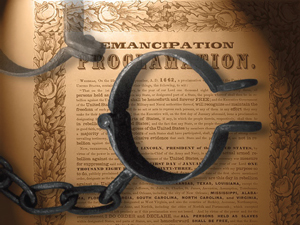The Emancipation Proclamation: From 3/5 Human to Second Class Citizenship
By Dr. Ron Daniels | Last updated: Jan 24, 2012 - 10:11:09 AMWhat's your opinion on this article?

|
This was celebrated as a momentous occasion because with a stroke of a pen, President Lincoln freed enslaved Africans from bondage. Certainly a just cause for celebration!
What was never noted in the Emancipation Day Programs was that the Proclamation did not “free” all of the four million enslaved Africans.
For Lincoln, the man the imminent historian Lerone Bennett, Jr. has called the “reluctant emancipator,” the Emancipation Proclamation was much more an economic and military strategy than a statement of moral and political principle.
The hard fact is that enslaved Africans were emancipating themselves in droves and flocking to the camps of Union Generals like Benjamin “Beast” Butler in New Orleans. Generals like Butler and radical Republicans like Congressman Thaddeus Stephens urged Lincoln to formally/officially free the enslaved Africans to strike a devastating blow to the economy of the South and, equally important, recruit them as soldiers to bolster the fortunes of an increasingly unpopular war in the North (by some estimates, more than 200,000 Blacks joined the Union Army).
Accordingly, Lincoln carefully crafted a Proclamation which would have maximum economic and military impact.
It freed enslaved Africans in those states that were in “rebellion” against the Union. If you were a slave in a state which had not seceded or declared war against the union—Missouri, Kentucky, Delaware or Maryland—you were still a slave after the pronouncement of the Proclamation. The Emancipation Proclamation left nearly a million Africans in bondage. This is why the 13th Amendment to the Constitution was necessary!

|
As Lerone Bennett, Jr. argues persuasively in his provocative book “Forced Into Glory: Abraham Lincoln’s White Dream,” Lincoln did not primarily prosecute the war to end slavery but to save the Union by whatever means necessary. And, while he no doubt found slavery morally repugnant, he was also convinced that Africans were inferior to Europeans and could not co-exist with them in the U.S. as equals.
He essentially viewed enslaved Africans as unfortunate captives who should be “emancipated” from bondage and protected from being oppressed by superior beings. This view was shared by most “abolitionists” of the day. It’s similar to the way animal rights activists view cats and dogs. This disposition was also consistent with the infamous 3/5 Compromise which the drafters of the Constitution adopted to persuade the Southern slaveholding states to join the new Federal Government. The Compromise provided that enslaved Africans, the chattel/property of Southerners, could be counted as 3/5 of a person/human being for the purpose of determining taxation and representation in the House of Representatives. It was also consistent with the Dred Scott Decision which decreed that enslaved Africans were “private property” and therefore could not be granted citizenship.
Though the signing of the Emancipation Proclamation and subsequent adoption of the 13th, 14th, 15th Amendments were welcome news, at best they moved the status of Blacks in America from 3/5 of a human being to “second class citizenship.”
Deeply ingrained perceptions of Africans as chattel and inferior human beings persisted, thereby severely limiting the definition of “emancipation” for formerly enslaved Africans in the South and their “quasi-free” Black kin in the North.
At the end of the Civil War, there were 4.5 million Africans in America, four million formerly enslaved Africans in the South and 500,000 “free Blacks” mostly in the North. For the most part, the four million Blacks in the South were woefully unprepared for their new found “freedom.”
And, while the Freedman’s Bureau and other programs were put in place to provide training for the formerly enslaved Africans to enter society, they were insufficient in scale and largely ineffective. But, the greatest handicap of all was the failure of the federal government to provide the “forty acres and a mule” which would have given them a stake in the American Capitalist political economy.
Not only were reparations repealed, as Claud Anderson documents in his brilliant treatise “Black Labor, White Wealth,” Blacks were deprived of an opportunity to participate in the Homestead Act and other “affirmative action” programs which benefited Euro-ethnic farmers and major business interests like the railroads.
As a consequence, the vast majority of formerly enslaved Africans were forced into a new form of peonage/quasi-slavery as sharecroppers, tenant farmers and agricultural laborers where it was virtually impossible to achieve self-sufficiency or accumulate wealth.
Moreover, under Southern Jim Crow Laws, certain jobs in the non-agriculture sector were “set aside” for Whites and in all instances Whites were paid more than Blacks for doing the same jobs. To add insult to injury, as Harold Barron documents in his excellent essay Demand for Black Labor, in the period after the Civil War until the turn of the century, the U.S. granted access to some 13 million European immigrants who quickly gained employment/jobs in the factories, foundries and mines in the North as the industrial revolution took hold.
These workers were ruthlessly exploited, often laboring long hours in unsafe conditions for very low wages.
However, millions of Blacks were confined to the South, laboring for no wages as sharecroppers and tenant farmers.
As bad as conditions were for the Euro-ethnics exploited in Northern workplaces, their condition was infinitely better than Africans subsisting under quasi-slave conditions in the South. The fruits of their anemic wages could be passed on inter-generationally, creating a passage to a better life for their progeny.
The condition of Blacks in the South constituted an intergenerational deficit for sons and daughters whose future was not much brighter than their parents.
Euro-ethnic immigrations would have a leg up on eventually achieving the “American dream.” For formerly enslaved Africans in the South, the future was bleak, a perpetual nightmare.
When “Johnny” went marching off to World War I, things changed.
Desperate to fill the void created by White men fighting the War, industrial bosses held their noses and vigorously recruited “darkies” from the South to man the jobs left open by Johnny’s departure for the frontlines in Europe. Finally, hundreds of thousands of Blacks would enter Northern labor markets as “wage earners” for the first time. Leaving the South for the North was like entering the “promised land.”
But, when Johnny came marching home, many of these Blacks lost their jobs, a pattern that soon came to be known as “last hired, first fired.” Indeed life in the “promised land” was less frightening but far from the full freedom the immigrants from the South had expected.
Blacks “up South” were supposedly “free,” but they were actually victimized by discrimination under a system of “de facto” segregation.
Despite the absence of Black Codes and Jim Crow Laws, in fact, Blacks were confined to certain neighborhoods, limited to working “Negro jobs” (menial, dirty and dangerous tasks) or constrained by a “White ceiling” on jobs which only permitted them to be promoted to a certain level. The high echelon jobs were “set aside” for Euro-ethnics. The differential in wages and opportunities between Blacks and Whites in the labor market in the North is another case where Euro-ethnics had the advantage in terms of passing on accumulated benefits and opportunities to the next generation. Once again, Africans in America bore the burden of intergenerational deficits, compared to their European counterparts.
While many in White America and some Blacks would like to dismiss these factors as irrelevant to the current crises facing Blacks in America, it is impossible to understand the wealth gap between Blacks and Whites and the relative underdevelopment of Black America without acknowledging this history. From the 3/5 Compromise to the Emancipation Proclamation, Reconstruction Amendments and Civil Rights Acts of the 1960s, Blacks in America have suffered from the perception of inferiority and deprived of access and opportunities which severely limited our progress as “second class citizens.”
It is an inescapable conclusion that the State of Emergency in Black America is in large measure due to ongoing intergenerational deficits resulting from our treatment as less than full citizens in these United States of America.
As we seek to heal our families and communities, we must be sober about the fact that even with a Black man in the White House, there is a significant minority of Whites who still view Blacks as less than equal.
More importantly, institutional/structural racism de facto remains a barrier to achieving full civil and human rights in this country.
Faced with this reality, Blacks in America must mobilize our internal capacity/power to shatter the psycho-cultural, economic and political walls of White supremacy once and for all. “We who believe in freedom cannot rest until we’ve won!”
Dr. Ron Daniels is president of the Institute of the Black World 21st Century and distinguished lecturer at York College City University of New York. His articles and essays also appear on the IBW website www.ibw21.org and www.northstarnews.com.
INSIDE STORIES AND REVIEWS
-
-
About Harriett ... and the Negro Hollywood Road Show
By Rabiah Muhammad, Guest Columnist » Full Story -
Skepticism greets Jay-Z, NFL talk of inspiring change
By Bryan 18X Crawford and Richard B. Muhammad The Final Call Newspaper @TheFinalCall » Full Story -
The painful problem of Black girls and suicide
By Charlene Muhammad -National Correspondent- » Full Story -
Exploitation of Innocence - Report: Perceptions, policies hurting Black girls
By Charlene Muhammad -National Correspondent- » Full Story -
Big Ballin: Big ideas fuel a father’s Big Baller Brand and brash business sense
By Bryan Crawford -Contributing Writer- » Full Story






 Click Here Stay Connected!
Click Here Stay Connected!








